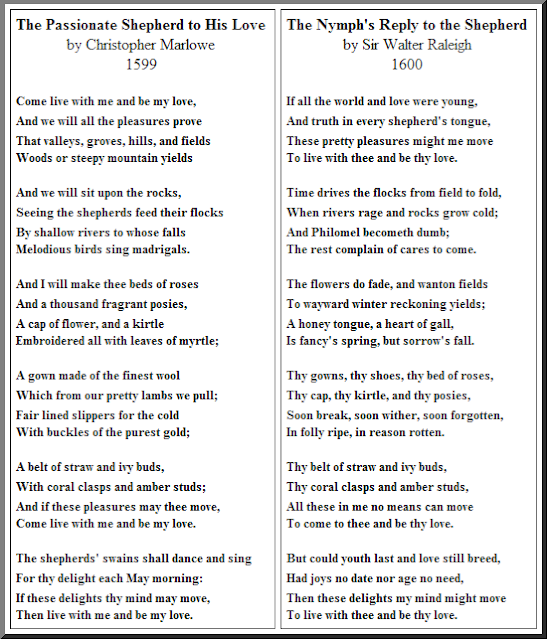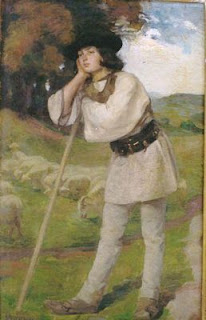“The
Passionate Shepherd to his Love” is a
pastoral poem written by Christopher Marlowe in 1599. It is meant to glorify the peaceful setting of the country
side.
Sir Walter Raleigh wrote a response to this poem in 1600 called "The Nymph's Reply to the Shepherd." He uses the young girl as the speaker, responding to the shepherd.
THE SHEPHERD
According to Dr. Debora B. Schwartz, Pastoral is a term that
comes from the Latin word for shepherd: pastor. The pastoral poem is one that
deals with shepherds and rustic life. This poem was set in a shepherd's field
or dwelling.
Christopher
Marlowe’s poem, “The Passionate Shepherd to His Love,” introduced to us a man’s
unyielding love for a woman and his determined quest for her to be his love.
The man offers the woman the beauty of nature, from the “melodious birds” to
“sleepy mountains,” in exchange for her hand.
The only information that we have about the speaker is that
he is a shepherd and thinks romantically and idealistically. Marlowe does not
focus much on the setting or character, but more on the argument that the shepherd is trying to make to the girl.
The prominent theme of this poem is of idealistic love and
pleasure.
Carpe diem was a popular subject in poems of this era, and
this also shows as a theme. The speaker urges his
love to live with him and enjoy the pleasures of the day.
love to live with him and enjoy the pleasures of the day.
THE NYMPH
This poem by Sir Walter Raleigh uses the same meter and references
to present "mirror images" of Marlowe's poem. He uses
the young girl as the speaker, responding to the shepherd. There are no clues
to the setting or the girl's physical appearance.The feminine persona (the nymph) of the poem sets up a
hypothetical set of questions that undermine the intelligence of the man's
offer because all that he offers is transitory.
Sir Walter Raleigh gives us the woman’s harsh, yet practical, response. “The Nymph’s Reply to the Shepherd” is a poem that contradicts Marlowe’s depiction of a “blooming” nature by describing the inevitable death of its beauty, while simultaneously comparing this death to the inevitable death of love.
The woman tells the shepherd no to love. she says soon the flowers will go away and die for winter. as plants change for seasons, so will his love change for her. she thinks he wont lover forever. she says it would be different if it was spring all the time (his love for her would never change) but this is impossible. she rejects his love. The young girl thinks realistically and refutes the ideas of the idyllic world the young man had proposed to her. The shepherd seems to be very much of an optimist, whereas the young girl is a pessimist. The structure of these two poems is exact.
A woman no matter how romantic has to be realistic, economic stablity is a major component of any realationship, any man making any promise better be able of fufilling it. No sensible women would marry for love alone because one can not live off love alone, we live off of gold! Women are economically interested along with supercial and call them what you will, but you can't argue that they are not smart.
They know all man woo them for one thing, instead of giving it up for free the hold out for a better offer, for a more handsome or wealthier suiter. In a time when women are treated as trophies they have to be savvy in order to survive. The nymph is just that she sends the shepherd with his flock and promises packing.




No comments:
Post a Comment